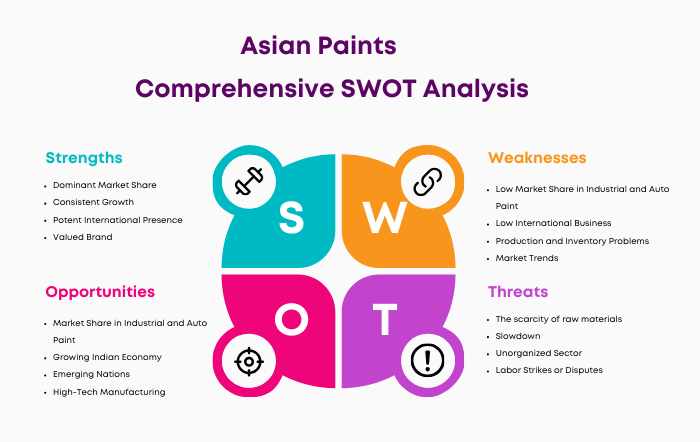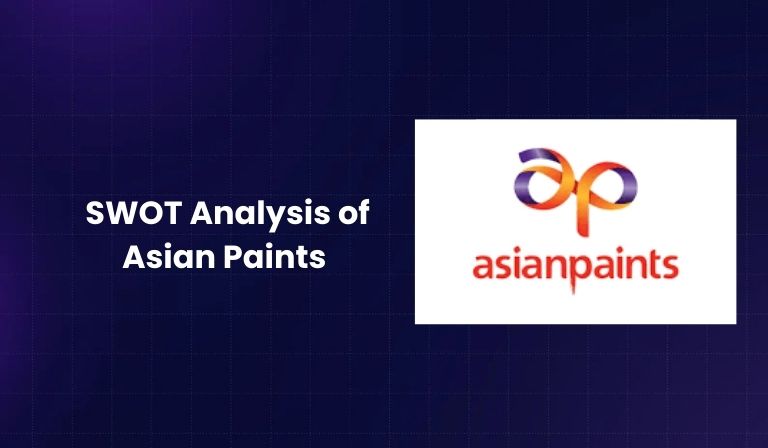Asian Paints, a leader in the global paint industry, has come a long way since its inception in 1942. Founded in India, the company has grown to become Asia’s third-largest paint manufacturer, with operations in over 60 countries worldwide. Over the decades, Asian Paints has maintained its leadership position through innovation, sustainability, and a commitment to quality. In this blog, we will conduct a comprehensive SWOT analysis of Asian Paints, breaking down its strengths, weaknesses, opportunities, and threats to understand how the company is positioned in 2025 and where it could be headed in the future.
Asian Paints is not just a brand but an institution in the paint industry. Headquartered in Mumbai, India, Asian Paints has successfully carved out a space for itself as the largest paint company in India and the third-largest in Asia. The company, founded by Champaklal Choksey, Chimanlal Choksi, Suryakant Dani, and Arvind Vakil, has always been a pioneer in technological advancements and innovative marketing strategies. Over the years, it has established a strong reputation for high-quality products, customer satisfaction, and sustainability.
In 2024, the company posted impressive financial figures with a revenue of ₹36,183 crore (US$4.3 billion), an operating income of ₹7,215 crore (US$860 million), and a net income of ₹5,558 crore (US$670 million). With a workforce of over 7,160 employees, Asian Paints continues to expand its footprint globally while reinforcing its leadership position in the paint industry.
Now, let’s dive into a detailed SWOT analysis of Asian Paints, which will help to evaluate its competitive position in the market as of 2025.
SWOT Analysis of Asian Paints

Strengths
Dominant Market Share
Asian Paints leads the Indian paint market with more than 50% market share. This dominant position signifies the brand’s vast consumer loyalty and trust. The company has effectively built a strong foundation, focusing on customer needs and preferences. Its market power is not just due to its extensive range of high-quality products but also because of the deep connection it has forged with its customers over the years. This significant market share makes it the go-to choice for both residential and commercial painting needs in India.
Asian Paints’ consistent market leadership is a direct result of its strategic decisions, which have helped the company remain ahead of competitors. The trust in its brand and the recognition of its superior products have made Asian Paints synonymous with paint in India.
2. Consistent Growth
Over the past five years, Asian Paints has maintained consistent financial growth at a rate of 8–12%. This sustained growth shows the company’s ability to adapt to market conditions, remain profitable, and expand its business. The strong financial performance has allowed Asian Paints to maintain its leadership position in the market, while also positioning itself for future expansion. Consistent growth ensures that the company remains competitive and relevant in an ever-evolving market, giving it the resources needed for further innovation.
3. Potent International Presence
Asian Paints’ global reach is another strength that differentiates it from many competitors. The company operates in over 60 countries, with manufacturing units spread across 27 locations globally. Its presence in key international markets gives it access to diverse consumer segments and opportunities for further growth. Notably, Asian Paints is one of the top five paint businesses in Asia, and its international footprint helps mitigate risks associated with over-reliance on the Indian market.
Asian Paints has been able to capitalize on emerging markets, leveraging its global reputation and technological expertise to expand its footprint. This expansion has helped the company build a robust consumer base outside India, solidifying its position as a global leader in the paint industry.
4. Valued Brand
Asian Paints is not just a household name in India but also enjoys a strong global reputation. In 2024, the company’s brand value was estimated at USD 1.5 billion, and it was recognized as one of the Top 20 Most Innovative Companies globally by The Economic Times. This recognition speaks volumes about the brand’s commitment to innovation and quality. The brand has built a strong identity, representing trust, reliability, and creativity. Its success is a result of a carefully crafted marketing strategy that continues to elevate its brand image across various markets.
5. Technological Advancements
Asian Paints has always been ahead of the curve when it comes to embracing new technologies. The company’s early adoption of supercomputers in the 1970s—decades before ISRO—helped it collect massive amounts of data, giving the company a significant competitive advantage. Today, Asian Paints continues to leverage cutting-edge technologies such as SAP ERP systems, digital color visualizations, and automation in manufacturing. These technological investments not only enhance operational efficiency but also give the company a competitive edge in terms of product quality and customer experience.
6. Diverse Product Range
Asian Paints has a diverse range of products that cater to different market segments, including residential, industrial, automotive, and ornamental paints. The company’s diverse offerings allow it to serve a wide array of customers and meet the needs of both mass markets and niche segments. Its products like Asian Paints Royale, industrial coatings, and decorative paints have helped it capture a broad customer base. This diversification also reduces the risks associated with market fluctuations, as Asian Paints can rely on multiple revenue streams.
7. Innovative Marketing
Asian Paints has established itself as a marketing powerhouse in the paint industry. The company has been known for its creative advertising campaigns, including its innovative use of celebrity endorsements, with stars like Saif Ali Khan and Deepika Padukone endorsing the brand. Its campaigns resonate well with consumers and have helped position Asian Paints as a premium yet affordable brand. Through consistent branding and innovative marketing techniques, the company has maintained strong brand visibility and consumer engagement.
8. Efficient Supply Chain Management
Asian Paints’ efficient supply chain management is powered by state-of-the-art systems such as SAP ERP. The company’s ability to integrate regional distribution and manufacturing plants gives it a significant advantage in terms of operational efficiency. This integration allows Asian Paints to meet market demand swiftly, reduce wastage, and ensure that products are always available to consumers. Its well-managed supply chain is one of the key reasons for the company’s ability to meet customer expectations consistently.
Weaknesses
1. Low Market Share in Industrial and Auto Paint
Despite its dominance in the decorative paint market, Asian Paints has only a 15% market share in industrial paints and 20% in the automotive paint market. These figures are significantly lower than competitors like Kansai Nerolac and AkzoNobel. While Asian Paints has been dominant in the decorative segment, its growth in these specialized areas remains limited. This indicates that Asian Paints may need to focus more on research and development and product differentiation to capture a larger share of the industrial and automotive sectors.
2. Low International Business
Although Asian Paints has a presence in over 60 countries, its international footprint remains relatively small compared to other global brands. The company’s global operations, while extensive, are still limited in scope, especially in key markets outside Asia and Europe. For Asian Paints to become a truly global brand, it must develop a more aggressive international strategy and tailor its products to meet local market demands.
3. Production and Inventory Problems
The decorative paints market is highly sensitive to changing consumer trends. Asian Paints faces challenges in production planning and inventory management due to the unpredictable nature of market demand. Inconsistent consumer preferences for colors and finishes make it difficult for the company to forecast demand accurately. Efficient demand forecasting, agile production methods, and flexible inventory management systems are necessary for Asian Paints to reduce wastage and keep pace with changing trends.
4. Market Trends
The paint industry, particularly in the decorative segment, is subject to rapid changes in consumer preferences. What may be popular today could be outdated tomorrow, making it difficult for companies like Asian Paints to maintain steady sales. Continuous market trend analysis and the ability to adapt to changing consumer needs are critical for maintaining competitiveness in this sector.
5. Potential Over-reliance on Physical Retail
While Asian Paints has a vast network of physical retail outlets, there is a risk of over-reliance on offline channels. With the growth of e-commerce and changing consumer purchasing behaviors, Asian Paints needs to build a more robust online presence. A shift toward an omnichannel sales strategy will allow the company to diversify its revenue streams and protect against potential declines in physical retail.
6. Infrastructure Maintenance
Asian Paints operates a large network of manufacturing, distribution, and retail facilities. While this infrastructure provides advantages in terms of supply chain efficiency, it also requires significant maintenance costs. The company must invest in optimizing its infrastructure to reduce operational overheads and improve profitability.
7. Labor Relations
Labor disputes in manufacturing facilities could disrupt production schedules and affect overall operations. Asian Paints must ensure that it maintains strong labor relations and creates a positive work environment to prevent disruptions in its supply chain.
8. Environmental Concerns
Asian Paints faces growing scrutiny over its environmental impact, particularly concerning volatile organic compounds (VOCs) emitted by its products. As regulations around environmental standards become stricter, Asian Paints must invest in green technologies and develop eco-friendly products to meet consumer demand for sustainable solutions and comply with environmental regulations.
Opportunities
1. Market Share in Industrial and Auto Paint
Asian Paints has the opportunity to increase its market share in the industrial and automotive sectors. By investing in high-performance coatings, research, and product innovation, Asian Paints can meet the growing demand for specialized coatings in these sectors, which are crucial for sectors like infrastructure, automotive, and manufacturing.
2. Growing Indian Economy
India’s growing infrastructure and construction boom offer a significant opportunity for Asian Paints to tap into new markets. Increased consumer spending, coupled with government schemes promoting home ownership and construction, will boost demand for paints. This economic growth provides Asian Paints with an ideal environment for expanding its presence in both rural and urban markets.
3. Emerging Nations
Emerging economies in Asia, Africa, and South America offer vast growth potential for Asian Paints. These markets are experiencing rapid urbanization and rising disposable incomes, making them prime targets for Asian Paints’ product offerings. By entering these markets early, Asian Paints can gain a first-mover advantage and establish itself as a dominant player in the region.
4. High-Tech Manufacturing
Investing in high-tech manufacturing processes will allow Asian Paints to improve production efficiency and reduce costs. By incorporating automation, data analytics, and precision manufacturing, the company can ensure that its products meet the highest quality standards and can be produced at scale to meet growing market demands.
5. Government Policies
Government initiatives focused on urban development, affordable housing, and infrastructure growth present significant opportunities for Asian Paints. The company can capitalize on these policies by aligning its product offerings with government projects and taking advantage of incentives for construction and building materials.
Threats
1. Scarcity of Raw Materials
Asian Paints, like many other manufacturers, is vulnerable to the volatility in raw material prices. Paint production relies heavily on materials like titanium dioxide, resins, and pigments, which are subject to supply chain disruptions and price fluctuations. Geopolitical conflicts, natural resource shortages, and trade restrictions could threaten the supply of these critical materials and impact production costs.
2. Slowdown in the Economy
Economic slowdowns, such as those caused by geopolitical tensions or pandemics, pose a threat to Asian Paints. Economic downturns often lead to reduced construction and infrastructure projects, directly affecting paint sales. Asian Paints must diversify its business to reduce its reliance on the construction sector and weather economic fluctuations.
3. Unorganized Sector
A large portion of the paint market in India is dominated by the unorganized sector. These smaller, often local businesses can offer products at lower prices, making it difficult for larger players like Asian Paints to maintain their market share. This unorganized sector poses a direct challenge to Asian Paints’ profitability and pricing strategy.
4. Labor Strikes and Disputes
Labor disputes, such as strikes and protests, could disrupt Asian Paints’ manufacturing and supply chain operations. Timely production delays may affect the company’s ability to meet demand and impact its overall profitability. Maintaining healthy labor relations and a positive work environment is crucial to mitigate this risk.
5. Imitation by Competitors
As the leader in the paint industry, Asian Paints faces constant competition from imitators. Other companies often try to replicate Asian Paints’ successful products, marketing strategies, or packaging designs. While imitation may be flattering, it can hurt Asian Paints’ brand equity and erode consumer loyalty.
6. Increasing Bargaining Power of Suppliers
If key suppliers consolidate or gain bargaining power, Asian Paints may face higher raw material costs. This could impact the company’s profit margins if it cannot pass on the increased costs to consumers.
Conclusion
Asian Paints has cemented its position as a market leader in the global paint industry through its innovation, quality products, and strong market presence. Despite facing challenges such as labor disputes, raw material shortages, and competition from the unorganized sector, the company’s future looks bright with numerous growth opportunities. With a strong focus on technology, sustainability, and market diversification, Asian Paints is well-positioned to maintain its leadership role in the ever-changing paint and coatings industry.
FAQs
What is Asian Paints’ market share in India?
Asian Paints holds over 50% of the Indian paint market, making it the undisputed leader in the country.
How can Asian Paints increase its market share in the industrial and automotive sectors?
Asian Paints can grow its market share in industrial and automotive paints by investing in high-performance coatings, research, and developing innovative solutions tailored to these industries.
What are the environmental concerns for Asian Paints?
Asian Paints faces environmental concerns regarding VOC emissions from its products. The company must focus on developing eco-friendly solutions to meet regulatory standards and consumer demand for sustainability.
What digital strategies is Asian Paints exploring?
Asian Paints is investing in digital engagement through AR-based color visualization, e-commerce platforms, and consumer experience enhancements to stay relevant in the digital age.
What are the threats that Asian Paints faces?
Asian Paints faces threats from raw material shortages, economic slowdowns, imitation by competitors, and labor strikes.
A digital marketer with a strong focus on SEO, content creation, and AI tools. Creates helpful, easy-to-understand content that connects with readers and ranks well on search engines. Loves using smart tools to save time, improve content quality, and grow online reach.

